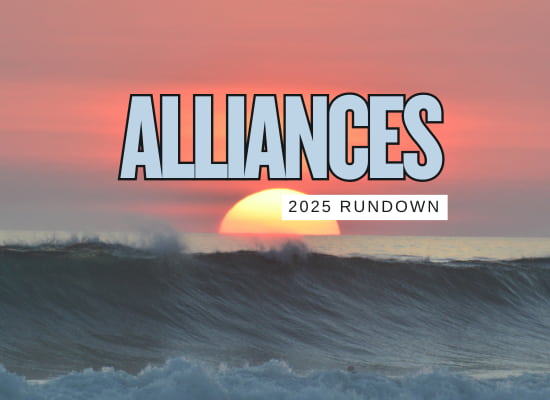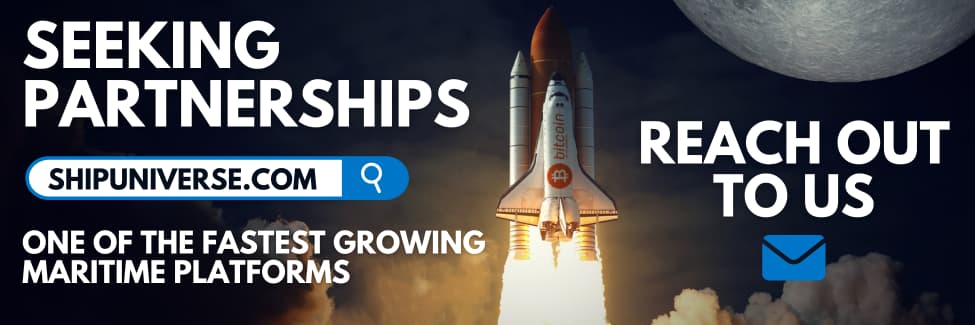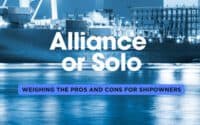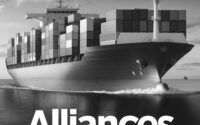Major Maritime Alliances to Watch in 2025

As global trade routes shift, security tensions rise, and the push for decarbonization accelerates, strategic maritime alliances are taking center stage in 2025. From high-profile defense pacts to quietly influential sustainability frameworks, these collaborations are shaping the future of shipping, port infrastructure, and naval operations. This rundown highlights the most impactful partnerships announced or active this year—each one signaling where the maritime world is headed next.

We welcome your feedback, suggestions, corrections, and ideas for enhancements. Please click here to get in touch.

 France–Indonesia Maritime Security Project
France–Indonesia Maritime Security ProjectQuick Rundown: In March 2025, France and Indonesia launched a strategic maritime security initiative focused on strengthening port resilience, increasing maritime domain awareness, and countering illegal activities in the Indo-Pacific. With implementation centered on Jakarta and Surabaya, the partnership blends infrastructure upgrades, security coordination, and joint planning—serving as a key regional response to rising geopolitical and trade route tensions.
 Importance:
Importance:
- Addresses piracy, trafficking, and regional instability in Southeast Asia’s busiest waters.
- Enhances bilateral cooperation and France’s Indo-Pacific maritime footprint.
- Bolsters Indonesia’s role as a maritime gateway between the Indian and Pacific Oceans.
 Areas of Collaboration:
Areas of Collaboration:
- Modernization of port security systems and surveillance tools.
- Information-sharing protocols and coordinated maritime patrols.
- Workshops and joint training on maritime law enforcement and response.
 Strategic Impact:
Strategic Impact:
- Signals Europe’s increasing stake in Indo-Pacific maritime security.
- May serve as a blueprint for future EU–ASEAN maritime cooperation frameworks.
 What to Watch:
What to Watch:
- Release of operational details and funding commitments expected mid-2025.
- Potential expansion into broader multilateral or regional coalition initiatives.
 Gemini Cooperation – Maersk & Hapag-Lloyd
Gemini Cooperation – Maersk & Hapag-LloydQuick Rundown: Two of the world’s largest container shipping companies—Maersk and Hapag-Lloyd—announced the Gemini Cooperation in early 2024, with operations officially launching in February 2025. The alliance brings together a fleet of around 290 vessels (3.4 million TEU capacity) into a unified network, aiming to deliver faster transit times, increased schedule reliability, and more connected ocean services across key trade lanes.
 Importance:
Importance:
- Redefines global container shipping dynamics outside traditional alliances like 2M or THE Alliance.
- Enhances schedule reliability—critical in post-pandemic recovery and just-in-time logistics.
- Strengthens digital integration and intermodal connectivity across Europe, Asia, and the Americas.
 Areas of Collaboration:
Areas of Collaboration:
- Joint vessel operations on core East-West trade routes.
- Development of a synchronized ocean and landside network.
- Data-driven planning and scheduling using shared digital tools.
 Strategic Impact:
Strategic Impact:
- Introduces a competitive alternative to existing shipping alliances.
- Pushes the industry toward greater transparency and operational efficiency.
- May influence port investment priorities and terminal negotiations globally.
 What to Watch:
What to Watch:
- Performance metrics in the first 6–12 months—especially reliability and customer satisfaction.
- Potential ripple effects on freight pricing and alliance restructuring across the sector.


 AUKUS Security Partnership – Australia, UK, USA
AUKUS Security Partnership – Australia, UK, USAQuick Rundown: The AUKUS pact—an ongoing trilateral security partnership between Australia, the United Kingdom, and the United States—continues to shape maritime strategy in 2025. Initially launched in 2021, the agreement focuses on delivering nuclear-powered submarines to Australia and enhancing advanced defense capabilities, including cyber, AI, and undersea technologies. Maritime security in the Indo-Pacific is a central pillar of the alliance.
 Importance:
Importance:
- Boosts deterrence in the Indo-Pacific amid escalating regional tensions.
- Strengthens Australia's long-term maritime defense posture and technological edge.
- Demonstrates Anglo-American alignment on defense strategy and military tech sharing.
 Areas of Collaboration:
Areas of Collaboration:
- Delivery of nuclear-powered submarines to Australia beginning in the early 2030s.
- Joint development in areas such as undersea warfare, quantum tech, and cybersecurity.
- Maritime surveillance and data sharing across strategic sea lanes.
 Strategic Impact:
Strategic Impact:
- Reshapes naval capabilities and partnerships in the Pacific theater.
- Challenges China's maritime expansion and reinforces alliance-based defense strategy.
- Triggers renewed focus on submarine deterrence and regional arms balancing.
 What to Watch:
What to Watch:
- Implementation progress on submarine construction and crew training programs.
- Expansion of AUKUS into other tech sectors like autonomous systems and hypersonics.

 India–France Maritime Cooperation Dialogue
India–France Maritime Cooperation DialogueQuick Rundown: Held in January 2025 in New Delhi, the 7th India–France Maritime Cooperation Dialogue reinforced the growing strategic partnership between the two nations. The dialogue focuses on maritime security, the blue economy, regional infrastructure, and coordination in the Indo-Pacific—reflecting both countries’ shared vision for a free, open, and rules-based maritime domain.
 Importance:
Importance:
- Deepens bilateral maritime ties in a region with rising competition and security risks.
- Strengthens France’s Indo-Pacific engagement and India’s naval diplomacy.
- Supports sustainable development initiatives tied to the ocean economy.
 Areas of Collaboration:
Areas of Collaboration:
- Joint naval exercises and coordinated patrols in the Indian Ocean.
- Maritime domain awareness and information-sharing mechanisms.
- Collaboration in maritime technology, logistics, and marine biodiversity protection.
 Strategic Impact:
Strategic Impact:
- Positions both nations as leading voices in shaping Indo-Pacific maritime governance.
- Promotes multilateral frameworks that balance China’s influence in the region.
- Opens avenues for broader EU–India maritime cooperation.
 What to Watch:
What to Watch:
- Follow-up agreements or joint projects stemming from the 2025 dialogue.
- Increased visibility of India–France naval coordination in regional hotspots.
 Premier Alliance Agreement (2025)
Premier Alliance Agreement (2025)Quick Rundown: Recognized by the U.S. Federal Maritime Commission in February 2025, the Premier Alliance Agreement marks a newly formalized partnership between major international carriers. While public disclosures remain minimal, its designation as a vessel sharing or cooperative working agreement suggests significant operational coordination on key trade routes.
 Importance:
Importance:
- Signals increased consolidation and alliance-building among global carriers.
- Could impact shipping lane optimization, capacity allocation, and rate structures.
- Reinforces the trend toward long-term strategic cooperation post-COVID disruption.
 Likely Areas of Collaboration:
Likely Areas of Collaboration:
- Joint scheduling and vessel sharing arrangements on trans-Pacific and Asia–Europe routes.
- Port terminal coordination and slot management.
- Integrated digital tools for routing and capacity management.
 Strategic Impact:
Strategic Impact:
- May influence market competition and freight pricing dynamics.
- Encourages further consolidation in the liner shipping sector.
- Could prompt regulatory scrutiny depending on market share and regional impact.
 What to Watch:
What to Watch:
- Disclosure of participating companies and route details in the coming months.
- Operational changes at key U.S. and Asian ports related to alliance implementation.

 DEHUKAM–NIMA Maritime Law Protocol
DEHUKAM–NIMA Maritime Law ProtocolQuick Rundown: Signed in February 2025 during the AMAN Dialogue in Karachi, this protocol marks a formal cooperation between Turkey’s National Center for the Sea and Maritime Law (DEHUKAM) and Pakistan’s National Institute of Maritime Affairs (NIMA). The partnership aims to advance academic collaboration, research, and policy development in maritime law and governance.
 Importance:
Importance:
- Promotes legal harmonization and capacity-building in maritime law across the region.
- Strengthens maritime legal institutions in both countries.
- Encourages policy research on emerging issues like maritime boundaries, fisheries, and port regulations.
 Areas of Collaboration:
Areas of Collaboration:
- Joint research projects on maritime security and international law.
- Faculty and student exchange programs between DEHUKAM and NIMA.
- Workshops, conferences, and publication of joint academic materials.
 Strategic Impact:
Strategic Impact:
- Strengthens Turkey–Pakistan maritime legal alignment and academic networks.
- Contributes to regional maritime governance through research-backed policy support.
- May influence legal frameworks and dispute resolution processes in the wider Indian Ocean region.
 What to Watch:
What to Watch:
- Outcomes from joint publications or legal studies announced in late 2025.
- Potential expansion to include other maritime law institutions in Central and South Asia.
 BIMCO–Achilles Strategic Partnership
BIMCO–Achilles Strategic PartnershipQuick Rundown: Announced in March 2025, this strategic partnership brings together BIMCO—the world’s largest international shipping association—and Achilles, a global leader in supply chain risk management. The goal is to standardize and digitize supply chain operations across the maritime sector, improving compliance, transparency, and operational efficiency for fleet operators and charterers.
 Importance:
Importance:
- Tackles fragmentation in global maritime supply chains with digital solutions.
- Helps companies meet tightening ESG and compliance standards.
- Introduces data-backed tools for procurement and supplier qualification.
 Areas of Collaboration:
Areas of Collaboration:
- Development of standardized risk management frameworks for suppliers.
- Launch of digital platforms for maritime procurement and compliance tracking.
- Training and onboarding for industry stakeholders using the new systems.
 Strategic Impact:
Strategic Impact:
- Streamlines vendor due diligence across the global maritime sector.
- Promotes ESG integration in ship operations and maintenance sourcing.
- Improves transparency for shipowners, regulators, and insurers alike.
 What to Watch:
What to Watch:
- Adoption rate among shipowners and suppliers in 2025–2026.
- Expansion into tools supporting decarbonization reporting and ethical sourcing.

 Pacific International Lines (PIL)–ABS MoU
Pacific International Lines (PIL)–ABS MoUQuick Rundown: Signed during Singapore Maritime Week 2025, this memorandum of understanding between Pacific International Lines (PIL) and the American Bureau of Shipping (ABS) focuses on advancing vessel decarbonization, safety, and design innovation. The collaboration supports both new ship builds and retrofit projects, with ABS providing modeling, simulation, and advisory services tailored to PIL’s operational goals.
 Importance:
Importance:
- Aligns with global regulatory pressure to cut shipping emissions and modernize fleets.
- Strengthens Singapore’s role as a hub for sustainable maritime innovation.
- Leverages ABS’s technical expertise to boost PIL’s competitiveness and ESG profile.
 Areas of Collaboration:
Areas of Collaboration:
- Decarbonization strategies for both existing vessels and newbuilds.
- Risk-based design assessments and performance modeling.
- Data-sharing for operational safety and emissions tracking.
 Strategic Impact:
Strategic Impact:
- Supports compliance with IMO emissions targets and evolving ESG frameworks.
- Improves operational safety and fuel efficiency across the PIL fleet.
- Potential to influence future class society partnerships with major carriers.
 What to Watch:
What to Watch:
- Results of retrofit trials and modeling impact on fuel savings.
- Expansion into alternative fuel readiness assessments and tech integration.
 CallMEBLUE–MEDBAN Strategic Framework
CallMEBLUE–MEDBAN Strategic FrameworkQuick Rundown: Finalized during the MEDBAN Conference in 2025, this strategic framework connects two major EU-backed initiatives—CallMEBLUE and MEDBAN—to foster long-term cooperation in the Mediterranean’s blue economy. The partnership is designed to support small and medium-sized enterprises (SMEs) by sharing resources, coordinating innovation programs, and amplifying access to sustainable maritime technologies.
 Importance:
Importance:
- Addresses funding and knowledge gaps for maritime startups and SME innovators.
- Strengthens the Mediterranean region’s role in driving sustainable maritime development.
- Unifies fragmented EU maritime innovation platforms under a cooperative model.
 Areas of Collaboration:
Areas of Collaboration:
- Joint support services for startups and early-stage maritime companies.
- Exchange of best practices in blue economy development, funding access, and training.
- Coordination of events, business missions, and networking initiatives.
 Strategic Impact:
Strategic Impact:
- Creates a long-term ecosystem for SME-led maritime innovation in the EU.
- Supports climate resilience, circular economy goals, and green port initiatives.
- May serve as a model for other regional blue economy clusters worldwide.
 What to Watch:
What to Watch:
- New EU funding mechanisms tied to this strategic alignment.
- Growth of cross-border maritime innovation projects under the shared framework.
The maritime landscape in 2025 is being quietly—but powerfully—reshaped by strategic alliances like the ones outlined above. Whether driven by geopolitical tension, decarbonization mandates, or the need for smarter digital infrastructure, these collaborations reflect where the industry is heading: toward deeper integration, shared innovation, and long-range security planning.
From major defense pacts to blue economy frameworks, each partnership adds a new layer to how the world’s fleets operate, cooperate, and evolve. As the year progresses, these alliances will likely set the tone for new regulations, investment strategies, and the next wave of maritime innovation.
Table Summary
| ShipUniverse: Major Maritime Alliances to Watch in 2025 (Part 1) | ||
| Alliance | Importance | Impact |
| France–Indonesia Maritime Security Project | A fresh bilateral push to boost port security and counter illegal activity in the Indo-Pacific, starting with Jakarta and Surabaya. | It’s a big deal for regional stability and shows France is serious about playing a long game in Southeast Asian waters. |
| Gemini Cooperation – Maersk & Hapag-Lloyd | Two container giants teaming up with 290 vessels to create a high-reliability, global shipping network. | It’s shaking up the traditional alliance structure and setting a new standard for on-time performance in ocean shipping. |
| U.S.–Japan–Philippines Trilateral Pact | A security pact with military, economic, and maritime coordination focused on the South China Sea. | This one's all about deterrence—backing up freedom of navigation with real cooperation and presence. |
| AUKUS Security Partnership | Australia, the UK, and the U.S. working together on nuclear sub tech, defense systems, and undersea capabilities. | This is about long-term balance in the Indo-Pacific. It's not flashy—but it’s foundational and has serious teeth. |
| India–France Maritime Cooperation Dialogue | Ongoing strategic coordination on security, sustainability, and shared Indo-Pacific goals. | It strengthens both countries' positions in the region and opens the door for more EU–India naval activity. |
| Premier Alliance Agreement (2025) | An FMC-recognized alliance—likely a vessel-sharing deal—between major carriers. Details are still emerging. | It hints at more consolidation ahead. Could shake up rates, port calls, and who controls key lanes. |
| DEHUKAM–NIMA Maritime Law Protocol | Turkey and Pakistan teaming up on maritime legal research and policy development through academic exchange. | It's not about ships—it’s about shaping the rules they sail under. This one’s all about long-term influence. |
| BIMCO–Achilles Strategic Partnership | BIMCO joins forces with supply chain platform Achilles to roll out digital tools for better maritime procurement and compliance. | This is about cleaning up the back-end. Smarter sourcing and ESG compliance is going to matter more than ever. |
| PIL–ABS MoU | Singapore’s PIL and ABS are teaming up on decarbonization strategies for both newbuilds and retrofits. | It's a practical alliance—helping real ships cut emissions without waiting for miracle tech. Smart and timely. |
| CallMEBLUE–MEDBAN Strategic Framework | An EU regional framework to support maritime startups and blue economy innovation across the Mediterranean. | It’s all about the ecosystem. This helps SMEs get funding, support, and networks that usually go to bigger players. |

Do you have a Maritime Product or Service that may be of interest to Shipowners? Tell us about it here!
Do you have feedback or insights? Please reach out to editor @ shipuniverse.com




